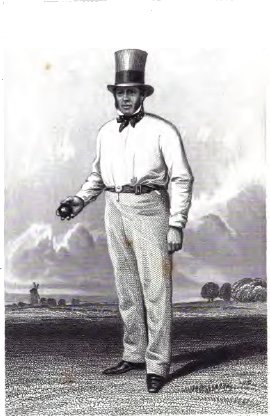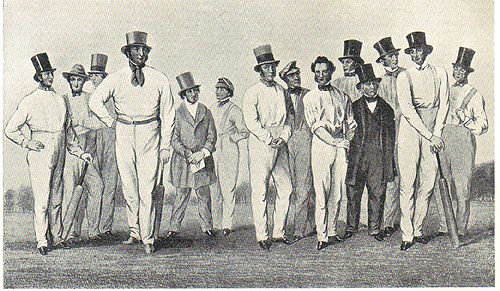
William Clarke (English cricketer)
Encyclopedia

Cricket
Cricket is a bat-and-ball game played between two teams of 11 players on an oval-shaped field, at the centre of which is a rectangular 22-yard long pitch. One team bats, trying to score as many runs as possible while the other team bowls and fields, trying to dismiss the batsmen and thus limit the...
er and team manager who played first-class cricket
First-class cricket
First-class cricket is a class of cricket that consists of matches of three or more days' scheduled duration, that are between two sides of eleven players and are officially adjudged first-class by virtue of the standard of the competing teams...
from 1826 to 1855. He founded, managed and captained the All-England Eleven
William Clarke's All-England Eleven
The All-England Eleven was an itinerant all-professional first-class cricket team created in 1846 by Nottinghamshire cricketer William Clarke. Widely known by its acronym AEE, it took advantage of opportunities offered by the newly developed railways to play against local teams throughout Great...
.
In the late 1820s, he lost sight in one eye after being struck there by a fives ball on the court behind the Bell Inn in Nottingham.
First-class career
Clarke was originally a bricklayer by trade, but from his earnings as a bowler and an advantageous marriage he was able in 1837 to take up the traditional cricketer's trade of publicanPublican
In antiquity, publicans were public contractors, in which role they often supplied the Roman legions and military, managed the collection of port duties, and oversaw public building projects...
. He became the owner of the Trent Bridge Inn after he married its widowed landlady. He opened the enclosed Trent Bridge
Trent Bridge
Trent Bridge is a Test, One-day international and County cricket ground located in West Bridgford, Nottinghamshire, England and is also the headquarters of Nottinghamshire County Cricket Club. As well as International cricket and Nottinghamshire's home games, the ground has hosted the Finals Day of...
cricket ground behind the inn and, from July 1840, it became the main venue for Nottinghamshire matches instead of the Forest racecourse, which was not enclosed. A stand at Trent Bridge has been named after Clarke.
Clarke was a great spin bowler
Spin bowling
Spin bowling is a technique used for bowling in the sport of cricket. Practitioners are known as spinners or spin bowlers.-Purpose:The main aim of spin bowling is to bowl the cricket ball with rapid rotation so that when it bounces on the pitch it will deviate, thus making it difficult for the...
. He began his first-class career as roundarm bowling
Roundarm bowling
In cricket, roundarm bowling is a style that was introduced in the first quarter of the 19th century and had largely superseded underarm bowling by the 1830s. Using a roundarm action, the bowler has his arm extended at about 90 degrees from his body at the point where he releases the ball...
was being introduced but he decided to persist with the slow right-arm underarm
Underarm bowling
In cricket, underarm bowling is as old as the sport itself. Until the introduction of the roundarm style in the first half of the 19th century, bowling was performed in the same way as in bowls, the ball being delivered with the hand below the waist...
leg-spin he had learned as a boy. In his career, he took 795 wickets at the outstanding average of 10.06 in 143 known first-class matches with a best analysis of 9/29. He took five wickets in an innings 82 times and ten wickets in a match 26 times. He was a moderate batsman, scoring first-class 2133 runs at an average of 10.35 with a highest score of 75. He took 55 catches.
Clarke played in the inaugural North v. South fixture at Lord's
Lord's Cricket Ground
Lord's Cricket Ground is a cricket venue in St John's Wood, London. Named after its founder, Thomas Lord, it is owned by Marylebone Cricket Club and is the home of Middlesex County Cricket Club, the England and Wales Cricket Board , the European Cricket Council and, until August 2005, the...
, this being his first appearance there.
He is believed to be the only player ever to take a first-class hat-trick
Hat-trick
A hat-trick or hat trick in sport is the achievement of a positive feat three times during a game, or other achievements based on threes. The term was first used in 1858 in cricket to describe HH Stephenson's feat of taking three wickets in three balls. A collection was held for Stephenson, and he...
that included the same batsman twice (i.e., John Fagge, the hat-trick spanning both Kent innings).
Captaincy
Besides his bowling, Clarke's greatest attribute was his captaincy and leadership. He was an astute tactician and perhaps the sport's first truly tactical captain who could "think out" the opposition by means of planned field positions and rotation of his bowlers. Taking the reins from Joseph DennisJoseph Dennis
Joseph Dennis was an English first-class cricketer who played for Nottingham Cricket Club from 1800 to 1829.-Career:...
, Clarke captained the old Nottingham town club from 1830 and automatically succeeded to the captaincy of Nottinghamshire County Cricket Club
Nottinghamshire County Cricket Club
Nottinghamshire County Cricket Club is one of the 18 major county clubs which make up the English and Welsh domestic cricket structure, representing the historic county of Nottinghamshire, and the current county champions. Its limited overs team is called the Nottinghamshire Outlaws...
when it was formed out of the town club in various stages between 1835 and 1840.
The All-England Eleven

William Lillywhite
Frederick William Lillywhite was a famous English cricketer during the game's roundarm era...
. Clarke had a great season in 1845 and few batsmen could play him well. Although most MCC ground staff were satisfied with their pay, Clarke was not and in 1846 he decided to take matters into his own hands. In August 1846, when the MCC season finished, he formed the All-England Eleven
William Clarke's All-England Eleven
The All-England Eleven was an itinerant all-professional first-class cricket team created in 1846 by Nottinghamshire cricketer William Clarke. Widely known by its acronym AEE, it took advantage of opportunities offered by the newly developed railways to play against local teams throughout Great...
(AEE) as a touring team of leading players to play matches at big city venues, mainly in the "unfashionable but prosperous" North of England. The team played three matches in 1846 against 22 of Sheffield, 18 of Manchester and 18 of Yorkshire. Clarke's team was indeed a top-class side worthy of its title and the matches in Sheffield, Manchester and Leeds were a huge success.
Clarke's touring team continued for several years to showcase the best players of the day and the venture became very profitable, especially for the entrepreneurial Clarke, who was careful to pay his players more than MCC did in order to keep them interested. He kept the surplus for himself and became very wealthy. John Arlott
John Arlott
Leslie Thomas John Arlott OBE was an English journalist, author and cricket commentator for the BBC's Test Match Special. He was also a poet, wine connoisseur and former police officer in Hampshire...
wrote of him: "He was the first man to make a fortune out of cricket; he was, also, the first to see that a fortune was to be made out of it." Because of its strength, the AEE generally played sides composed of twenty-two men, though these odds were reduced when opposed to such sides as Sheffield, Manchester, some county teams and the rival United All-England Eleven
United All-England Eleven
The United All-England Eleven was an English cricket team formed in 1852 by players breaking away from William Clarke's All-England Eleven . Key UEE players included John Wisden and Jemmy Dean, who became joint secretaries of the team....
.
Clarke had a reputation for being autocratic, and the United All England XI was formed in opposition the his AEE partly because their players disliked his style.
Clarke died at his home, Priory Lodge, Wandsworth Road, on 25 August 1856. He was buried at West Norwood Cemetery
West Norwood Cemetery
West Norwood Cemetery is a cemetery in West Norwood in London, England. It was also known as the South Metropolitan Cemetery.One of the first private landscaped cemeteries in London, it is one of the Magnificent Seven cemeteries of London, and is a site of major historical, architectural and...
.

